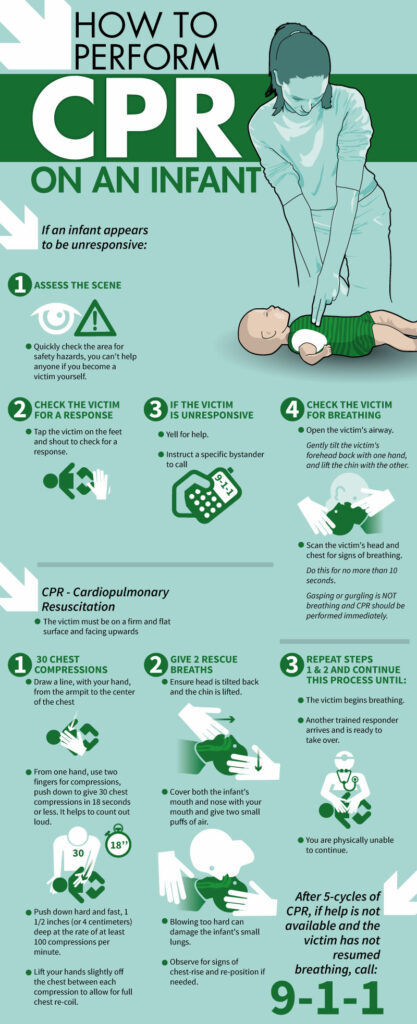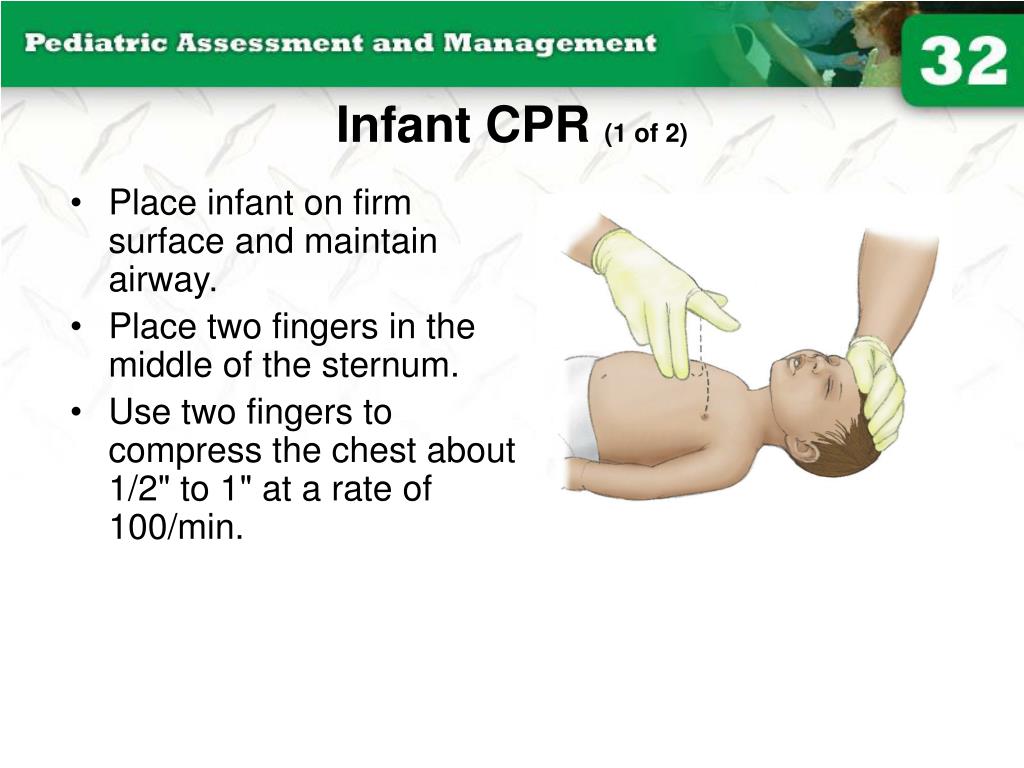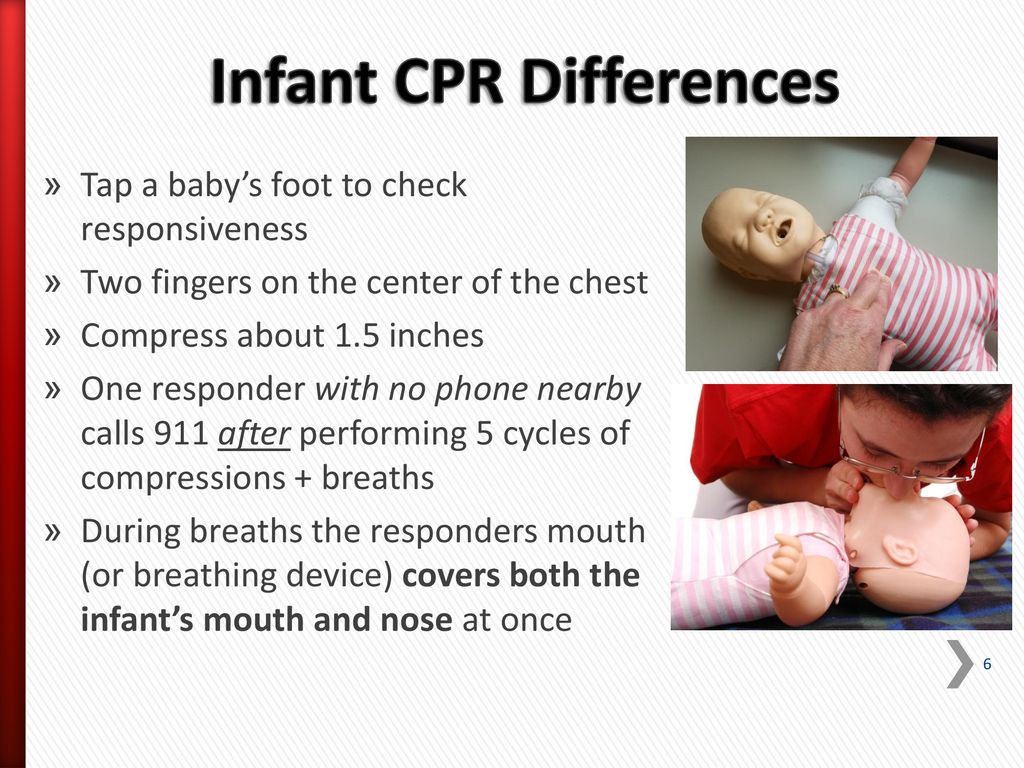For a child open the airway to a slightly past-neutral position using the head-tiltchin-lift technique. We offer certification in ProFirstAid adult child infant and ProFirstAid Basic adult only.

Performing Cpr On A Child Or Infant Wonder Web Development
Adult use 2 arms 2 depth compression.

. - the adult does not need rescue breaths before the cycle of CPR. When checking for responsiveness candidates should tickle or wiggle the feet of a infant instead of. Blow into the child or babys mouth for about 1.
For a baby open the airway to a neutral position using the head-tiltchin-lift technique. Rescue breathes one-rescuer In chapter 3 rescue breath techniques in children and infants were discussed. The 6 Major Differences in CPR between a Adult Child and a Infant.
95 the rule of thumb is to use pediatric AED pads for infants and children up to 8 years old or weighing less than 55 pounds That is to say anyone above 55 pounds. In lay rescuer you may do adult only CPRAED or adult child and infant CPRAED. In either case if you dont know the age of the childinfant you shouldnt hesitate to provide CPR.
Also lay rescuers do not check for a pulse. - if alone you must work on a child for 2 mins then call 911. Infant use 2 fingers less compression only 1 ½ depth.
Rescuers must ask for permission before approaching and helping a infant. Also with child and infant CPR you should do 5 cycles first before you call 911 if you are alone. Push down 4cm for a baby or infant or 5cm a child which is approximately one-third of the chest diameter.
According to the guidelines you should do 30 chest compression with either one hand or two fingers one hand if it is a child two fingers if it is an infant and two breaths. Although all of us here at Cardio Partners hope that youll never be called upon to perform CPR on a child its important to understand the very significant differences between the three types of CPR. 6 CPR provides a Window of Opportunity for someone.
This may hold true for children in most parts. Explain when and how to move a child or infant from a dangerous scene. CPR for children is slightly different from CPR for adults or even CPR for infants.
Therefore a persons size has much to with the way CPR is done. What are the differences between child infant CPR and adult CPR. The place where you check for a pulse in infants is different than for children and adults.
Describe the three emergency action steps. Get Certified In FA CPR AED. With an adult you call 911 first.
Differences between child and infant rescue breaths one-rescuer Child Take normal breath then seal your mouth. Explain the difference between Adultchild CPR and infant CPR. A child is a person that is no longer an infant but has not yet reached the age of puberty.
Ad Group Discounts Available Nationally Recognized Online Courses. Lay Rescuer CPR. Lay Rescuer CPR is much more simplified.
Identify the difference between consent and implied consent. Infants or babies or newborns. The only real difference is that with a baby your mouth is covering the babys mouth AND nose and your compressions are with two fingers instead of the whole hand.
Ad Free CPR Online Course Complete our Course and Get Nationally Certified Now. According to the CPR Participants Book pg. Between the two versions 2-rescuer CPR is better.
Important Differences Between Adult Child and Infant CPR Adult CPR. Adult CPR is the version that most of us are familiar with whether its from TV or a First Aid course. Different ages of people require a different set standard for CPR ratios.
Due to their different physiology bone density and musculature child CPR should be practiced on children up. Instead of using the carotid artery check for a pulse on the inside of the upper arm where the brachial artery is found. Were the first to admit that the idea of performing cardiopulmonary resuscitation CPR on an infant or child is pretty scary.
To perform rescue breathes on an unresponsive and not breathing or not breathing normally child or infant in cardiac arrest follow instructions in Table 44. Important Differences Between Adult and Child CPR CPR stands for cardiopulmonary resuscitation which involves assisting someone of any age when his or her heartbeat and breathing have stopped. Lay rescuers also only learn 1 person CPR.
One of the main differences between children and adults is age as the average age of a child with cardiac arrest is about eight years old so there are slight modifications to how CPR works on them as opposed to an adult patient. Demonstrate how to perform CPR on a child patient explain factors that can increase a patients survival rate 5. Anyone less than a year should be considered an infant.
Together is also known as two-rescuer CPR 2-rescuer CPR or two-person CPR 2-person CPR. Lay rescuer CPR is most often needed for. For instance a Barro-chest burly man may require a strong person to push.
King County Emergency Medical Services. Identify how to minimize the risk of disease transmission when giving care. The main difference is that you begin by 5 introductory breaths because children can swallow some toy or something and choke on it and the whole point of these breaths is to push the obstruction.
Providing chest compressions to keep the blood moving when the heart isnt pumping and providing rescue breathing to give the. Anyone 1-8 years old is considered a child. Get Certified And Help Save A Life.
Explain when and how to call 9-1-1 or the local emergency number. An Adult you call then work on them. For instance a baby is different than a child a child is different than the average adult and the average adult is different than the elderly person.
Because a childs physiology. Child use 1 arm compressed to 2 depth. Explain how CPR is different for a child than an adult 17.
Ad Hands-On Flexible Classes In Locations Near You. Release the pressure then rapidly repeat at a rate of about 100-120 compressions a minute. Affordable CPRAED Online Training Available.
When to Use Child CPR. After 30 compressions tilt the head lift the chin and give 2 effective breaths. There are two main steps to CPR.
Because one person is at the chest performing compressions and one person is at the head giving rescue breaths its not as tiring and theres less of a delay between compressions and breaths.

Ppt Infant Cpr 1 Of 2 Powerpoint Presentation Free Download Id 747198


0 Comments